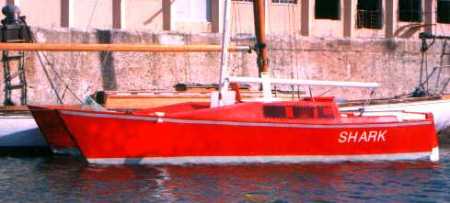Articles
Janus Owners Comments
From a letter in May 1993
"When I decided to quit wetsuit sailing and build a small, reasonably priced but exciting cruiser, I chose the Strider's baby sister, the almost unknown Janus.
Why should such a superb little trailer sailor have failed to catch on in Britain with tight budget backyard amateurs like me? Fair enough, she's a skinny person's boat with proportionately less sleeping and cooking space than the Strider, but performance wise - without making any extravagant claims - she is a super rough weather weekender with commendable aspects.
From my experience of one-and-a-bit seasons I have found the Janus, with her semi-planing hulls, put up a fair show in all reasonable conditions.
With the weight of two crew on her solid sailing decks she is always stable, responds well to the helm and refuses to dig her bows in, even in five foot waves. In a Force five offshore northerly breeze Two Fishes sprinted from the Deben to Harwich with long planing surges, and with a following wind and sea (the most scary point of sail with many multis) she was always under control, and without a reef never gave a hint of any intention to broach.
Light as a feather the Janus moves adequately with only a 2hp outboard, even against a 4 knot
tide. It's not true that she floats on a pint of water - but almost!"
And then from a letter August 1995
"I should apologise for leaving you without any news or pictures of our two epic crossings to Holland in Two Fishes our Janus which is proving a really good little boat.
My crew is an excellent navigator and we have had four brilliant seasons. I would never have attempted such ambitious voyages without his inspiration, but we have now logged hundreds of miles including a crossing to Flushing, 120 miles straight across the North sea last year, and the same landfall this year - via Ramsgate, Dunkirk, Ostende and Breskens."
And from an Australian owner
"I sail regularly at 8 knots. I have had her to 11 knots but I then usually lose my nerve. We have sailed her in more extreme conditions in 2m high frequency swell in the gulf with 25knot winds gusting 30 and she handles it well. She is a dry boat especially when compared to some tri-marans.
She always draws attention wherever she goes, especially around popular beaches.
She is a great young family boat and makes a fantastically stable boat at 3.95m wide. There is no bobbing around like an excited cork when at anchor. The hulls provide privacy as required. Our family of 4 has spent a week at a time on the boat sailing Gulf St Vincent in Adelaide."
Quote from a builder in Iceland
"The plans are more than excellent - even a kid could build from the plans. "
And from a owner in Australia
"Great boat - tacks without hesitation in light air. Sailing 4 to 6 knots in a 7 to 10 knot breeze. With 4 adults and 4 children. Great! Would recommend the boat to anyone who is not a couch potato."
A Bettencamp Portugal
"After 7 months your 29th Janus was ready. She is fast, really fast. I noticed several times when only 10 - 12m monohulls could keep up. Once friends commented "He's going very fast - he must have a good engine!" Engine, there is no engine, only sails!"

And then, in reply to these questions from a prospective builder
John, could you tell me how wide the forward bunks are? and how much do you miss the 100mm head room on the port aft bunk? You don't look cramped in the picture.
John replied
"At your hip it will be 540mm and then widens to your shoulders at the BHD which is 600mm. Keep in mind that the gunwale is at around 900 wide at the widest point. An Australian house door is 860 wide. A double bed is 1370 wide which really gives you and your partner 700mm each to sleep in. I think you get where I am going with this - there is enough room.
Missing the aft headroom? Not at all! With the aft bunk raised, headroom is not impeded because there is not much to start off with on that side. You wouldn't sit upright in the aft bunks unless you are as small as a child. Raising it by 100mm makes a wider bunk and brings your feet closer to the beam boxes. I do not find this an issue.
Keep in mind that this bunk extends into the cabin by 350mm and this is where your head is now positioned. This also provides you with a better seat than in the aft bunk on the other hull. Entering and exiting the cabin is different but not harder.
The good thing is that you can build the hulls and once completed in real 3D you can decide on whether you think it is a good idea or not. I simply glued another stringer in place at the correct height and did the same as for the other bunks. We overnight in the Gulf and we need that porta-potti, and unless you have a cuddy this is the next best thing."









